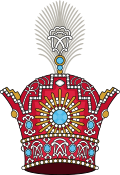Padishah
| Part ofa serieson |
| Imperial, royal, noble, gentry and chivalric ranksinWest,Central,South AsiaandNorth Africa |
|---|
 |
Padishah(Persian:پادشاه;lit. 'Master King';fromPersian:pād[orOld Persian:*pati], 'master', andshāh,'king'),[1][2]sometimesromanisedaspadeshah,patshah,padshahorbadshah(Persian:پادشاه;Ottoman Turkish:پادشاه,romanized:pâdişâh;Turkish:padişah,pronounced[päː.d̟i.ʃɑː];Urdu:بَادْشَاہ,Hindi:बादशाह,romanized:baadashaah), is a superlativesovereigntitleof Persian origin.
A form of the word is known already fromMiddle Persian,or Pahlavi language, aspātaxšā(h)orpādixšā(y).[3][4][5][6]Middle Persianpādmay stem fromAvestanpaiti,[7]and is akin toPati (title).Xšāy,"to rule", andxšāyaθiya,"king", are fromOld Persian.
It was adopted by severalmonarchsclaiming the highest rank, roughly equivalent to the ancientPersiannotion of "Great King",and later adopted by post-Achaemenidand theMughal emperorsof India. However, in some periods it was used more generally for autonomous Muslim rulers, as in theHudud al-'Alamof the 10th century, where even some petty princes of Afghanistan are called pādshā(h)/pādshāʼi/pādshāy.[8]
The rulers on the following thrones – the first two effectively commanding majorWest Asianempires – were styled Padishah:
- TheShahanshahofIran,originating mainly with theSafavids
- ThePadishahof theOttoman Empire
- TheBadshahofHindustan,used by theMughals
- Some Seljuk rulers, likeGrand SeljukAhmad Sanjar(aspadishah-i sharq-u gharb,a translation of the Arabicmalik al-mashriq wa al-maghrib[King of the East and the West]),Sultan of RumKaykhusraw I(asPadishah of Islam), and Sultan of RumKayqubad I(aspādshāh).[9]
- MongolIlkhanGhazantook the titlePadshah-i Islamafter he converted to Islam in 1295, possibly in order to undermine the religious prestige of theMamluk Sultanatein Egypt.[10]The titleIlkhan,that came into usec. 1259–1265, may be an equivalent ofPadishah,if it is taken to mean "sovereign khan" (and not "subordinate khan" as often posited).[11]
- Miangul Golshahzada Abdul Wadud(predecessor styledAmir-i shariat,successors [Khān and]Wali) of thePakistaniNorth-West Frontierstate of Swat,who called himselfbadshahfrom November 1918 to March 1926.
- Ahmad Shah Durrani,who founded theDurrani Empirein 1747 with the titlePādshah-i Afghanistanin Persian andBadcha Da Afghanistanin thePashto language.TheSadduzaiwere overthrown in 1823 but there was a brief restoration byShah Shujahin 1839 with the help ofBritish India&Ranjit Singhand theSikh Empire.The title became dormant from his assassination in 1842 until 1926 whenAmanullah Khanresurrected it (official from 1937) and was finally laid to rest with the abdication ofMohammed Zahir Shahin 1973 following a coup; at other times the Afghan monarchy used the styleEmir(Amir al-Momenin)orMalik( "King" ).[12]
- The lastBashabeyofTunisia,Muhammad VIII al-Amin(proclaimed bey on 15 May 1943), adopted thesovereignstylepadshah20 March 1956 – 25 July 1957.
- The female monarchRaziaof theDelhi Sultanateused the masculine titlepadshah.
The compound Pādshah-i-Ghazi( "Victorious Emperor" ) is only recorded for two individual rulers:
- Ahmad Shah Durrani,Emperor of theDurrani Empire(r. 1747–1772)
- Rustam-i-Dauran, Aristu-i-Zaman,Asaf Jah IV,Muzaffar ul-Mamaluk, Nizam ul-Mulk, Nizam ud-Daula, Nawab Mir Farkhunda 'Ali Khan Bahadur [Gufran Manzil], Sipah Salar, Fath Jang, Ayn waffadar Fidvi-i-Senliena, Iqtidar-i-Kishwarsitan Muhammad Akbar Shah Padshah-i-Ghazi,Nizam of Hyderabad(r. 1829–1857)
- TheSikhsusе the term Padishah forGodand the 10gurus.Padishah is also used for the 10th and last Guru of SikhsGuru Gobind Singh.[13][14]
Like manytitles,the wordPadishahwas also often used as a name, either bynobleswith other (in this case always lower) styles, or even bycommoners.
Padshah Begumis the title of consorts ofpadishahs.
Ottoman Empire
[edit]
In the Ottoman Empire the title padishah was exclusively reserved for the Ottoman emperor, as the Ottoman chancery rarely and unwillingly addressed foreign monarchs as padishahs. TheHabsburg emperorswere consequently denied this title and addressed merely as the "kings of Vienna" (beç kıralı).[15]With thePeace of Zsitvatorokin 1606, it was the first time that theSublime PorterecognizedRudolf IIas equal of the padishah.[16]TheTreaty of Küçük Kaynarcain 1774, gave similar concessions to theRussian Empire.[17]
In Ottoman sources
[edit]According toAhmedi'sİskendernâme,one of the earliest Ottoman sources, alongside the titlessultanandbeg,OrhanandMurad Ibore the title padishah as well.[18]
See also
[edit]References
[edit]- ^Etymonline, s.v."pasha"ArchivedOctober 6, 2013, at theWayback Machine.
- ^Bartbleby Dictionary & Etymology
- ^MacKenzie, D. N. (1971).A concise Pahlavi dictionary.London. p. 63.ISBN978-1-136-61396-8.OCLC891590013.
{{cite book}}:CS1 maint: location missing publisher (link) - ^"pad(i)shah."The Oxford Dictionary of English Etymology.Retrieved September 22, 2021 from Encyclopedia:https:// encyclopedia /humanities/dictionaries-thesauruses-pictures-and-press-releases/padishahArchived2021-10-05 at theWayback Machine
- ^"[ pādixšā(y) – Encyclopedia Pahlavica ]".Archivedfrom the original on 2021-10-05.Retrieved2021-10-05.
- ^Horn, Paul (1893).Grundriss der neupersischen Etymologie.University of Michigan. Strassburg, K.J. Trübner. p. 61.
- ^"[ Pad – Encyclopedia Pahlavica ]".Archivedfrom the original on 2021-10-08.Retrieved2021-10-08.
- ^Babinger, Fr. & Bosworth, C.E. (1995)."Pādis̲h̲āh".InBosworth, C. E.;van Donzel, E.;Heinrichs, W. P.&Lecomte, G.(eds.).The Encyclopaedia of Islam, Second Edition.Volume VIII:Ned–Sam.Leiden: E. J. Brill.ISBN978-90-04-09834-3.
- ^Korobeĭnikov, Dimitri (2014).Byzantium and the Turks in the Thirteenth Century.Oxford, United Kingdom. pp. 99–101, 290, 157.ISBN978-0-19-870826-1.OCLC884743514.
{{cite book}}:CS1 maint: location missing publisher (link) - ^Charles Melville, "Padshah-i Islam: the conversion of Sultan Mahmud Ghazan KhanArchived2021-10-09 at theWayback Machine",Pembroke Papers I, ed. C. Melville, Cambridge: Middle East Centre, 1990: p. 172.
- ^Kyle Crossley, Pamela (2019).Hammer and Anvil: Nomad Rulers at the Forge of the Modern World.Rowman & Littlefield. p.162.ISBN978-1-4422-1445-3.
- ^"Countries Ab-Am".rulers.org.Archivedfrom the original on 2018-06-26.Retrieved2005-06-22.
- ^श्रद्धा के साथ मनाया पंच पातिशाही गुरु अर्जुनदेव महाराज का शहीदी पर्वArchived2021-08-15 at theWayback Machine(in Hindi).Dainik Bhaskar.1916.
- ^Kaur, Madanjit (2021-05-15).Guru Gobind Singh: Historical and Ideological Perspective.Unistar Books.ISBN978-81-89899-55-4.
- ^Peter Fibiger Bang; Dariusz Kolodziejczyk (2012).Universal Empire: A Comparative Approach to Imperial Culture and Representation in Eurasian History.Cambridge University Press. p. 178.
- ^Kenneth Meyer Setton (1991).Venice, Austria, and the Turks in the Seventeenth Century.p. 22.
- ^Bernard Lewis (2002).What Went Wrong?: Western Impact and Middle Eastern Response.p. 164.
- ^Halil Inalcik (1988–2016)."PADİŞAH پادشاه İslâm devletlerinde çok geniş ülkelere sahip hükümdarlara verilen unvan.".TDV Encyclopedia of Islam(44+2 vols.)(in Turkish). Istanbul:Turkiye Diyanet Foundation,Centre for Islamic Studies.
External links
[edit]- Babinger, Fr. & Bosworth, C.E. (1995)."Pādis̲h̲āh".InBosworth, C. E.;van Donzel, E.;Heinrichs, W. P.&Lecomte, G.(eds.).The Encyclopaedia of Islam, Second Edition.Volume VIII:Ned–Sam.Leiden: E. J. Brill.ISBN978-90-04-09834-3.
